Tire Size 285/60r20 vs 285/65r20
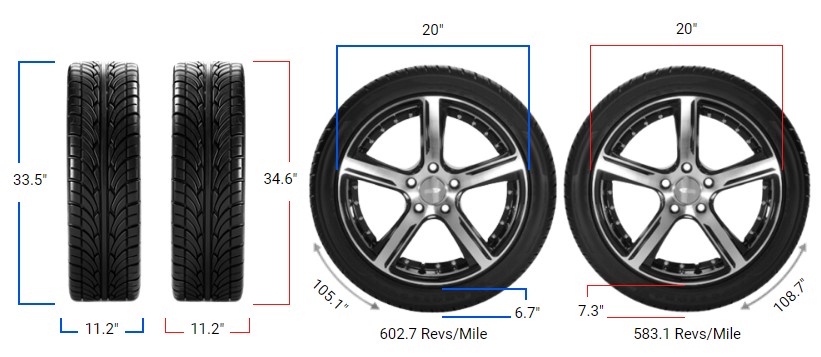
Are you considering upgrading your 285/60R20 tires to a taller 285/65R20 size? While the width stays the same at 285 mm, the 65 aspect ratio provides a 14.25 mm (0.56 in) taller sidewall than the 60 series.
- 3.4% increase in overall diameter may require vehicle modifications for proper fitment
- 1.12 inch increase in ground clearance improves off-road capability
- 8.3% taller sidewall enhances ride comfort and protects against damage
- Speedometer will read 3.4% slow (actual speed will be faster than indicated)
- Slight reduction in fuel economy due to increased rolling resistance
285/65r20 vs 285/60r20
This table will provide a quick overview of the differences to help you better understand.
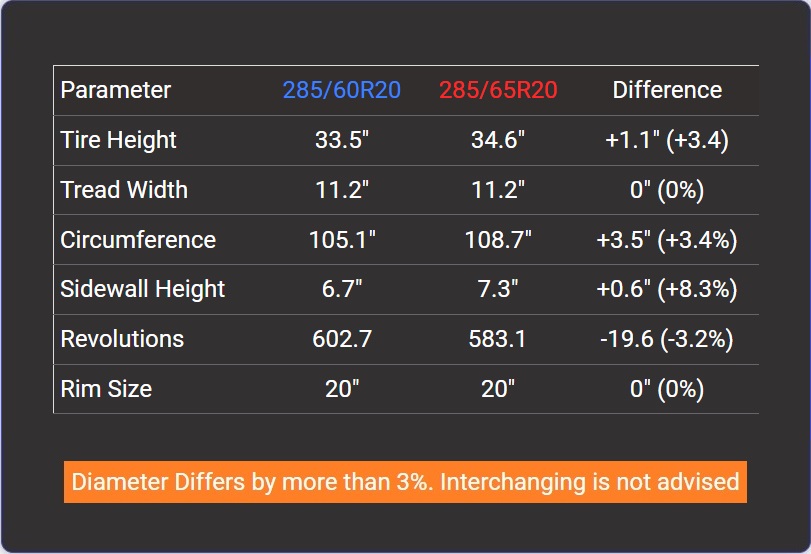
Fitment Guide
The overall diameter of the 285/65r20 is 3.4% larger than the 285/60r20. Replacement tires should be within 3% of the original size to prevent clearance issues or speedometer inaccuracy.
The 285/65r20 may require minor adaptations like a leveling kit to fit properly and avoid rubbing at a complete turn.
Gas Mileage
With a marginally smaller contact patch and rolling resistance, the 285/60r20 is slightly more fuel-efficient than the 285/65r20.
This can lead to minor but meaningful fuel savings over time, making the 285/60r20 a smart choice for daily drivers focused on efficiency.
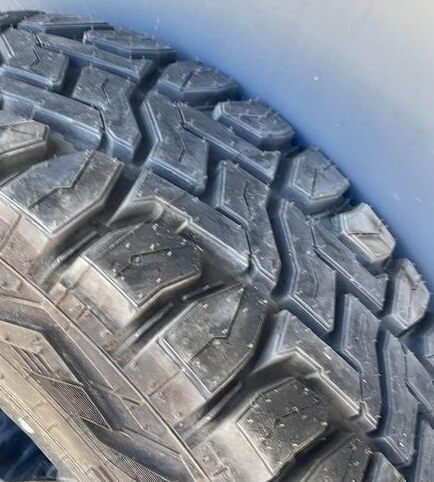
Ground Clearance
The taller sidewall of the 285/65r20 provides an extra 0.56 inches (14 mm) of ground clearance over the 285/60r20.
This added clearance is useful for navigating rough, uneven terrain without scraping or damaging the undercarriage. However, the larger diameter 285/65r20 causes a lower speedometer reading.
Ride Comfort
The softer sidewall of the 285/65r20 absorbs road impacts better than the 285/60r20, potentially providing a smoother, more comfortable ride over cracked or bumpy pavement. This cushier ride comes at a small cost of handling precision.
Aesthetics
Visually, the difference is subtle, but the 285/65r20’s additional sidewall height gives it a slightly “stretched” look compared to the 285/60r20’s shorter sidewall.
For some vehicles, this taller profile aesthetically suits trucks and SUVs better than a low-profile tire.
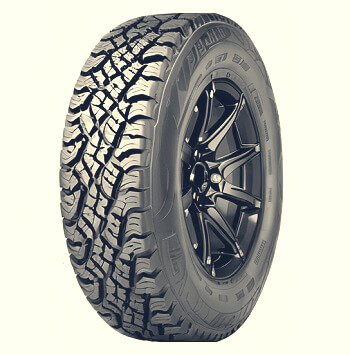
Handling & Stability
The 285/60r20 offers sharper, more responsive handling with a shorter, stiffer sidewall than the 285/65r20.
However, both deliver stable handling for normal driving conditions. The 285/65r20 gains a handling advantage on loose or uneven surfaces.
Noise & Vibration
The 285/60r20’s stiff sidewall transmits more road noise and vibration into the cabin compared to the shock-absorbing 285/65r20.
However, the two sizes’ noise and ride quality differences are relatively minor.
Durability & Wear
The lower-profile 285/60r20 exhibits slightly more even tire wear compared to the flexing 285/65r20.
Both deliver comparable tread life if rotated regularly. The taller 285/65r20 places marginally more stress on suspension components.
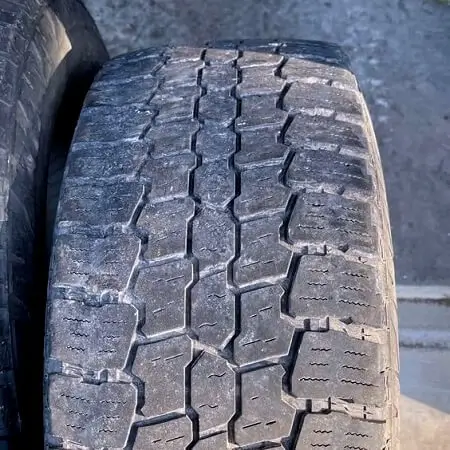
Adverse Conditions
Both sizes perform similarly across wet, snowy, and off-road conditions. The extra ground clearance of the 285/65r20 provides a small advantage in navigating ruts, rocks, and over rough terrain.
Speedometer Difference
At an actual speed of 20 mph, the speedometer reads 20.67 mph with 285/65r20 tires versus 20 mph with 285/60r20 tires.
This 0.67 mph speedometer difference results from the larger diameter of the 285/65r20.
What Does 285/60r20 Tire Mean?
The first number in a 285 60r20 tire size 285 refers to the width of the tire in millimeters. The second number, 60, is the aspect ratio.
This number indicates what percentage of the tire’s width is made up of the height of the sidewall. In this case, 60% of 285mm. The last number in size, 20, is the diameter of the wheel that the tire is designed to fit.
What is the Main Difference Between 285/60r20 and 285/65r20?
The main difference between 285/60R20 and 285/65R20 tires is the 3.4% increase in overall diameter due to the taller 65 series sidewall.
Can I Use 285/65r20 Instead of 285/60r20?
In most cases, you can use 285/65R20 tires in place of 285/60R20, as long as your vehicle has sufficient clearance to accommodate the 1.12 inch (28.5 mm) taller tire.
However, the 3.4% change in overall diameter may require modifications to ensure optimal performance and avoid rubbing.
How Much Taller is a 285/65r20 Tire Than a 285/60r20?
A 285/65R20 tire is 1.12 inches (28.5 mm) taller than a 285/60R20 tire. This is due to the taller sidewall of the 65 series tire, which is 7.29 inches (185.25 mm) compared to the 6.73 inch (171 mm) sidewall of the 60 series tire.
Our Observation
After analyzing the differences between 285/60R20 and 285/65R20 tire sizes, we believe that the taller 65 series offers worthwhile advantages for most applications – especially for off-road and mixed terrain use.
The gains in ground clearance, sidewall durability, ride quality and traction outweigh the minor speedometer error and potential fuel economy reduction.
Fitment should be carefully verified for each specific vehicle, but in most cases, 285/65R20s can replace 285/60R20s with the right considerations.
The end result is a truck or SUV that sits a little taller, rides a little smoother, and tackles tougher terrain with greater ease.

Meet Caitlin McCormack, a Tire Size Expert and Blogger Passionate About Everything Related to Tires. With Years of Experience in the Tire Industry, Caitlin Has Become an Expert in Tire Sizes and Their Impact on Vehicle Performance.
